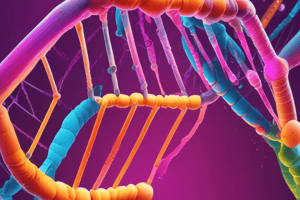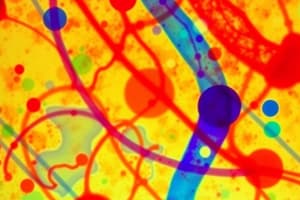Podcast
Questions and Answers
What is the primary purpose of gel electrophoresis?
What is the primary purpose of gel electrophoresis?
- To separate DNA, RNA, or proteins based on size or charge (correct)
- To create DNA primers
- To synthesize new DNA molecules
- To amplify DNA sequences
In the first cycle of PCR, how many DNA molecules are produced?
In the first cycle of PCR, how many DNA molecules are produced?
- 1 molecule
- 4 molecules
- 8 molecules
- 2 molecules (correct)
Which component is essential for PCR to amplify target DNA?
Which component is essential for PCR to amplify target DNA?
- DNA primers (correct)
- RNA polymerase
- Gel matrix
- Electric field
What is the main role of a DNA ladder in gel electrophoresis?
What is the main role of a DNA ladder in gel electrophoresis?
How many DNA molecules are produced in the third cycle of PCR?
How many DNA molecules are produced in the third cycle of PCR?
What type of gel is commonly used for separating large DNA fragments?
What type of gel is commonly used for separating large DNA fragments?
Gel electrophoresis separates molecules based on several factors. Which of the following is NOT one of those factors?
Gel electrophoresis separates molecules based on several factors. Which of the following is NOT one of those factors?
What is the primary purpose of adding a dye during the loading of DNA samples in electrophoresis?
What is the primary purpose of adding a dye during the loading of DNA samples in electrophoresis?
What is a crucial advantage of using PCR in conjunction with gel electrophoresis?
What is a crucial advantage of using PCR in conjunction with gel electrophoresis?
How are the lengths of DNA fragments determined during agarose gel electrophoresis?
How are the lengths of DNA fragments determined during agarose gel electrophoresis?
What does agarose gel electrophoresis indicate about PCR products?
What does agarose gel electrophoresis indicate about PCR products?
Which statement is true regarding the visibility of DNA bands after electrophoresis?
Which statement is true regarding the visibility of DNA bands after electrophoresis?
Which of the following techniques helps verify the size of DNA fragments produced by restriction enzyme digests?
Which of the following techniques helps verify the size of DNA fragments produced by restriction enzyme digests?
What is the role of a DNA marker ladder in electrophoresis?
What is the role of a DNA marker ladder in electrophoresis?
What outcome does successful agarose gel electrophoresis produce for PCR products?
What outcome does successful agarose gel electrophoresis produce for PCR products?
What purpose does ligation serve in molecular biology?
What purpose does ligation serve in molecular biology?
What type of plasmid will only contain the gene of interest after the ligation reaction?
What type of plasmid will only contain the gene of interest after the ligation reaction?
What is the purpose of transforming ampicillin-sensitive E. coli with plasmids?
What is the purpose of transforming ampicillin-sensitive E. coli with plasmids?
What characteristic allows bacteria transformed with plasmids to grow on ampicillin-containing media?
What characteristic allows bacteria transformed with plasmids to grow on ampicillin-containing media?
Which of the following describes a blue colony after plating on medium containing X-gal?
Which of the following describes a blue colony after plating on medium containing X-gal?
What is a key difference between recombinant and nonrecombinant plasmids?
What is a key difference between recombinant and nonrecombinant plasmids?
What role does the lacZ gene play in the selection of transformed bacteria?
What role does the lacZ gene play in the selection of transformed bacteria?
During the transformation procedure, why do some bacteria take up DNA while others do not?
During the transformation procedure, why do some bacteria take up DNA while others do not?
Which step is critical for distinguishing between recombinant and nonrecombinant colonies after transformation?
Which step is critical for distinguishing between recombinant and nonrecombinant colonies after transformation?
What is the primary purpose of reverse transcription?
What is the primary purpose of reverse transcription?
Which component is added to the mRNA during the reverse transcription process to initiate DNA synthesis?
Which component is added to the mRNA during the reverse transcription process to initiate DNA synthesis?
In what direction does reverse transcriptase synthesize the DNA copy from the mRNA?
In what direction does reverse transcriptase synthesize the DNA copy from the mRNA?
What happens to the mRNA strand after the DNA synthesis is completed?
What happens to the mRNA strand after the DNA synthesis is completed?
What type of nucleic acid molecule is produced after the degradation of the mRNA strand?
What type of nucleic acid molecule is produced after the degradation of the mRNA strand?
What role does oligo(dT) play in the reverse transcription process?
What role does oligo(dT) play in the reverse transcription process?
What type of enzyme is reverse transcriptase classified as?
What type of enzyme is reverse transcriptase classified as?
How is the hybrid nucleic acid molecule formed during reverse transcription?
How is the hybrid nucleic acid molecule formed during reverse transcription?
What is the result of generating a homozygous gene knockout in mice?
What is the result of generating a homozygous gene knockout in mice?
What is the primary advantage of using the CRISPR-Cas system over traditional gene editing methods?
What is the primary advantage of using the CRISPR-Cas system over traditional gene editing methods?
In gene therapy, what is the goal of introducing a normal gene into specific cell lines?
In gene therapy, what is the goal of introducing a normal gene into specific cell lines?
What distinguishes germline gene therapy from somatic gene therapy?
What distinguishes germline gene therapy from somatic gene therapy?
What kind of cells are impacted by somatic gene therapy?
What kind of cells are impacted by somatic gene therapy?
What components of the CRISPR system act as a defense against foreign DNA?
What components of the CRISPR system act as a defense against foreign DNA?
Which option describes the role of sgRNA in the CRISPR-Cas system?
Which option describes the role of sgRNA in the CRISPR-Cas system?
Why is germline gene therapy not allowed in humans?
Why is germline gene therapy not allowed in humans?
Flashcards are hidden until you start studying
Study Notes
Polymerase Chain Reaction
- PCR is a technique used to amplify DNA sequences
- The PCR technique uses specific primers which target known DNA sequences
- Each cycle of PCR doubles the amount of DNA
- The amplified DNA sequences can then be analyzed using gel electrophoresis
Gel Electrophoresis
- A technique that separates DNA by size
- PCR fragments are separated by size in an agarose gel
- Larger fragments migrate slower than smaller fragments
- The fragments are visualized under UV light
Agarose Gel Electrophoresis
- Separates DNA, RNA, or proteins according to size
- Used in research to analyze PCR products and restriction enzyme digests
- DNA ladders are used to determine the size of the fragments
- Bands of DNA can be compared to known size markers to determine size
Reverse Transcription
- Converts mRNA to cDNA
- Uses a primer to bind to the poly(A) tail of the mRNA
- Reverse transcriptase uses DNA precursors to synthesize a complementary DNA copy of the mRNA
- RNase enzyme degrades the mRNA strand
- The result is a single strand of cDNA
Programmable RNA-Guided Genome Editing System
- The CRISPR-Cas system is a natural immune system to foreign DNA in bacteria and archaeal cells
- The CRISPR-Cas system has been modified to be a programmable RNA-guided genome editing system in research
- The CRISPR-Cas system uses sgRNA to direct Cas9 to a specific DNA sequence
- Cas9 is a protein that cuts the DNA sequence
- By targeting specific DNA sequences, the system can be used to make gene knockouts, insertions, and other modifications
Gene Therapy
- Introduction of normal genes into cells to correct genetic disorders
- Germline gene therapy targets the germline cells and is not allowed in humans
- Somatic gene therapy targets somatic cells in the body
- Somatic cells are cultured, transformed, and reintroduced into the body
Studying That Suits You
Use AI to generate personalized quizzes and flashcards to suit your learning preferences.




